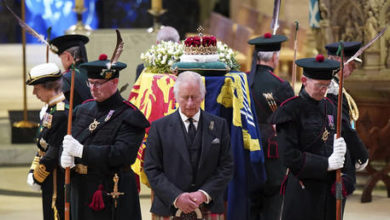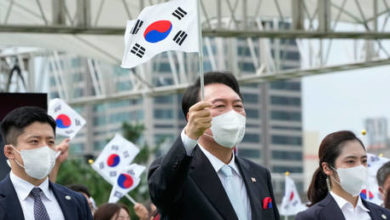Putin May Just Be Winning the Information War

Are Vladimir Putin and Ukraine losing the information warfare?
It all depends on whom you ask.
It’s never easy to measure such things, but here are a few numbers.
While 141 countries in the UN voted to condemn Russia’s aggression, the number of African, Middle Eastern and South American countries who have imposed sanctions on Russia is 0.
Yesterday, President Joe Biden held a summit in Washington with eight members of the Association of Southeast Asian countries. He pressured them into criticizing Russia. They responded with silence
When the Russian Federation released an official list of “unfriendly” nations, no country from Africa, Asia, or South America was on the list, and neither was India or China—the two most populous countries in the world—both of which have been pretty chummy with Putin.
Yes, Putin is losing the information war in Europe and America, but he’s holding his own elsewhere.
According to the Economist Intelligence Unit, two-thirds of the world’s population live in countries who are neutral about the war or support Russia. While China is an ally of Russia, the big non-aligned nations—Brazil, South Africa, Saudi Arabia, the United Arab Emirates—voted against Russia in the UN, but resolutely refuse to criticize Putin.
Part of the reason for this is that two-thirds of the world doesn’t see the war that we see. The balkanization and exploitation of the internet is partly responsible. Today there are three types of internet. There’s The American and Western internet which we think of as the internet. There’s the unfree internet in places like Russia, Turkey, and India where content is restricted and policed. And then there’s the Chinese internet, which is censored and not at all free. The Chinese internet—used by one out of five of the world’s internet users—is pro-Russian. The unfree internet in Turkey, India, and other countries allows them to access much of their wartime information via Russian state media. They are not seeing Zelensky’s nightly invocations to democracy. These are images of Russian noble soldiers. These are two of the most popular hashtags used on Indian social media: #IStandWithPutin & #IStandWithRussia
There were many stories about Ukraine’s victory in the Information War with Russia in America, Western media and elsewhere within the United States in the initial weeks following the invasion. Zelensky’s inspiring nightly speeches; the destroyed Russian tanks on Instagram and TikTok; the Ukrainian social media influencers decrying Putin’s invasion. Ukrainians had an authentic story and were agile, modern, and real.
By contrast, Russia’s messaging efforts were top-down, clumsy and slow—a little like their invading army. When Russia annexed Crimea in 2014, the notorious Russian troll farm was almost unknown. Its use of fake personas and phony blogs and posts as well as malicious bots seems to have been the current state of disinformation.
Back then, Russia had the advantage of surprise—remember the Russian troops in Crimea that were first described as “little green men”? There have been reports that Russian speakers were harassed in Crimea. Many people did not connect this disinformation storm to a Russian-run troll farm that was housed in an unmarked structure. That was two years before the 2016 election and long before the Mueller report detailed Russia’s efforts to interfere in that election.
Putin broadcast his attempts for several weeks and months. He had over 100,000 troops on the border of Ukraine but couldn’t or wouldn’t explain what they were doing there. The Russians were pioneers in what is called hybrid warfare—the mixture of information war and kinetic war—but the Russian military machine seemed to have no meme battle plan or even how the war would be seen on social media.
Read More: Inside Zelensky’s World
Russian messaging was sophisticated in 2014, but they didn’t get much better. Everyone else did. In 2014, text was the dominant medium on social media. This is now the age of real-time videos. Zelensky understands this; Putin doesn’t.
In 2015, while working in the Obama State Department I went to Ukraine to assist with their messaging. Their then acting information minister asked me the first question: “What’s a press confer?” It was a very hopeless situation. They were pretty hopeless. But, over the years, American funding and European training in social media and fact-checking helped to jumpstart their transformation.
With their TikTok Influencers and numerous channels on Telegram they’re very up to date. . They’ve even launched a state-sponsored volunteer IT army which has been carrying out cyber-attacks on Russian targets. In the early days of the war, they put out a call for volunteers on the messaging app Telegram—which has been the main digital battlefield of the war. A half-million people answered the call. For white hat hackers, they created an open-source platform to combat the Russians. Russia Today was closed for just one day after the invasion. This was almost like the Spanish Civil War when people volunteered to fight, but with laptops.
On March 6, 2022, activists and supporters of Hindu Sena (a right-wing Hindu organization) participated in a marche in support Russia. (Photo: Sajjad HUSSAIN / AFP). (Photo via SAJJAD HUSSAIN/AFP via Getty Images
AFP via Getty Images
But while Russia’s messaging has been clunky and old-school, let’s not forget, we are not the primary target. Putin has multiple audiences, but his most important audience—and his most reliable one—is domestic. Miburo found that 85% of Russians obtain their majority information through Russian state media. They get an incessant diet of Nazis from Ukraine, claims about Ukraine not being a nation, fears that Ukraine might be pursuing genocide, as well as the generosity and professionalism of the Russian military. It’s a simple formula: Russian state media is a projection of how Putin sees the world. According to the Levada Center in Russia, one of the country’s few independent pollsters, more than half of Russians see NATO and the U.S. as the cause of the conflict. Only 7% blames the Kremlin.
As if this relentless state propaganda was not enough, Russia is inoculating its own domestic audience against Western and international narratives about Ukraine by creating a host of fake fact-checking shows and organizations to pre-emptively undermine any news that contradicts Putin’s narrative. Russia’s largest state channel, Channel One, has created a show called “AntiFake” that rebuts what they say are false stories about the war in Ukraine. It employs all the tropes of fact-checking—statistics, forensic analysis, black-and-white video to prove that claims about Russian atrocities are made-up and staged. The Russian Ministry of Foreign Affairs posts “Your Daily #Fake” which includes short videos debunking Western claims about the invasion. There’s a Russian channel on Telegram—where so much of the digital battle for truth is going on—called “War on Fakes” which says it is debunking “the information war against Russia.”
Telegram is the main battlefield in the Information War in Ukraine. It is the instant news channel for the war—used by both the Ukrainians and the Russians. Zelensky also has Telegram channel where he speaks directly in Russian to Russians. Russia has created numerous channels on Telegram. Information wars are more secretive today than ever because most of it is hidden on an encrypted platform which doesn’t broadcast.
It is also difficult to see the information war these days because the platforms have abandoned neutrality, and taken sides. Facebook, YouTube and Twitter have all blocked Russian messages. YouTube declared a worldwide block on Russian state media, and pulled over 1000 channels from its site and removed 15,000 videos. Facebook blocked access to Russian media outlets Russia Today, Sputnik and the European Union. It also banned Russian state media advertising. Netflix has suspended its Russian service. These are new territories for platforms that have long wished to be apolitical. Russian courts declared Facebook to be an extremist organisation in response.
Continue reading: Ukraine is in worse shape than you think
Zelensky might be the TikTok Popeill, and an advocate for Ukrainian democracy. But he’s taken some very undemocratic decisions at home. Zelensky banned 11 Ukrainian party members in March for their Russian connections. Most of the parties were small, but one, the Opposition Platform for Life, has 44 seats in the 450 seat Ukraine parliament and is Ukraine’s largest opposition party. The Opposition Platform for Life is headed by an oligarch from Ukraine who has close connections to Putin. Zelensky, who claimed national security reasons, effectively ended the independent broadcasting of television in Ukraine that month by consolidating all national channels under one state platform. This wasn’t much reported on in the West, but it was headline news in Russia and China. Former Russian president Dmitry Medvedev posted the following on his Telegram channel: “The most democratic president of Modern Ukraine has taken another step towards the Western idea of democracy… He completely banned any activity by opposition parties in Ukraine. Well done!”
The U.S. and European Union made a mistake in portraying war as Russia versus the West, or Democracy versus Autocracy, for the international audience. While this meme works well in America and Europe it is less effective among non-aligned and developing nations. In Africa, most of Asia and the Middle East the West was the colonizers that did not allow democracy in the countries they ruled. A better way of mobilizing these countries against Russia is to depict the war as a fundamental, illegal violation of Ukrainian sovereignty, as an imperialist Russia trying to violently expand its own borders That’s something they can relate to. These non-aligned nations don’t hearken to America’s frequent invocation of the “free world.” What they want is some acknowledgement from America and the West that they will at least get rhetorical support if their borders are violated. Kenya’s ambassador to the U.N. rebuked Russia without mentioning democracy or autocracy—or Putin for that matter. “Kenya, and almost every African country, was birthed by the ending of empire. They were drawn by someone else. They were drawn in the distant colonial metropoles of London, Parks, and Lisbon.” Russia, he suggested, is simply trying to repossess a now independent colony.
Even if we exaggerate Ukraine’s expertise on the information battlefield, and underplay the extent of Russian influence, I do think we are sometimes deceiving ourselves by talking about information war when there is a real war going on. It is true that there is an information warfare in Ukraine. The war. This is the war. Every day, people die in it. Homes and schools are constantly being bombed. This simplistic way of viewing things is based on the idea that you can win or lose an information war. It can be used to blind us from the horrors of conflict. No, a tank can’t stop a meme, but a meme certainly cannot stop a tank. Memes may wound people’s egos, but they don’t kill them. The information war can be won and lost. Franco won the actual war, while the republican freedom fighters won in the Spanish Civil War. Let’s hope that is not what happens in Ukraine.
Here are more must-read stories from TIME





